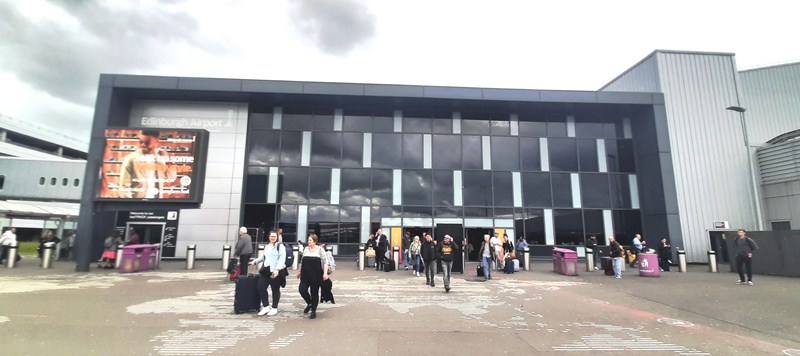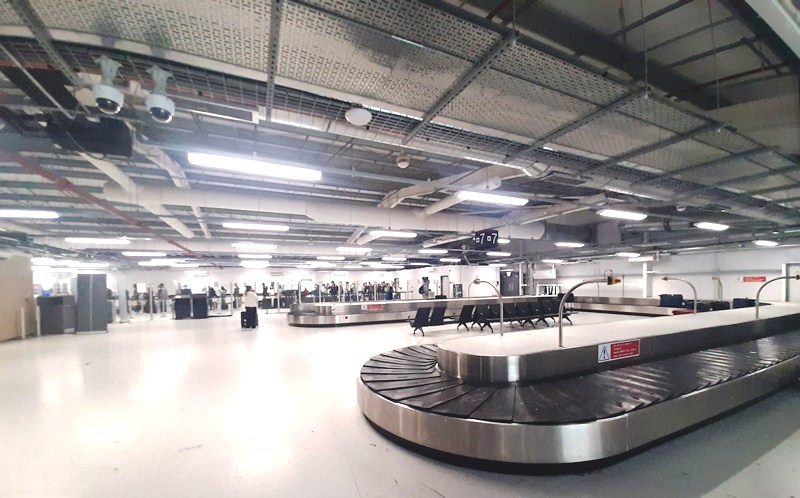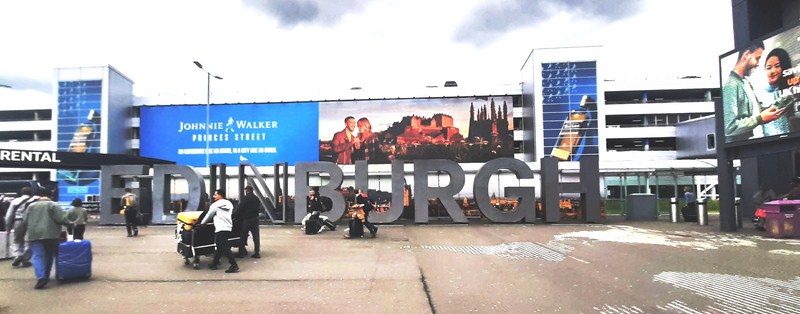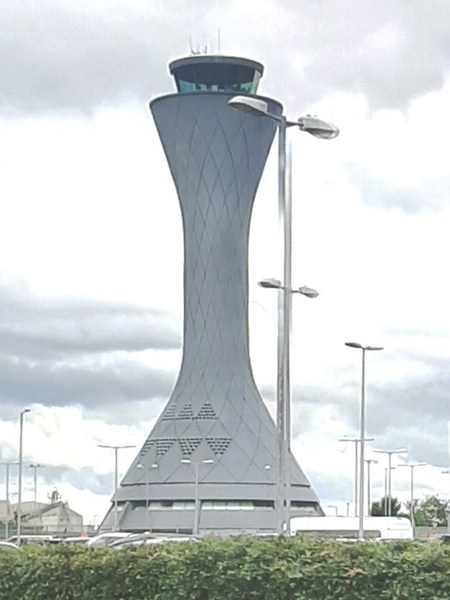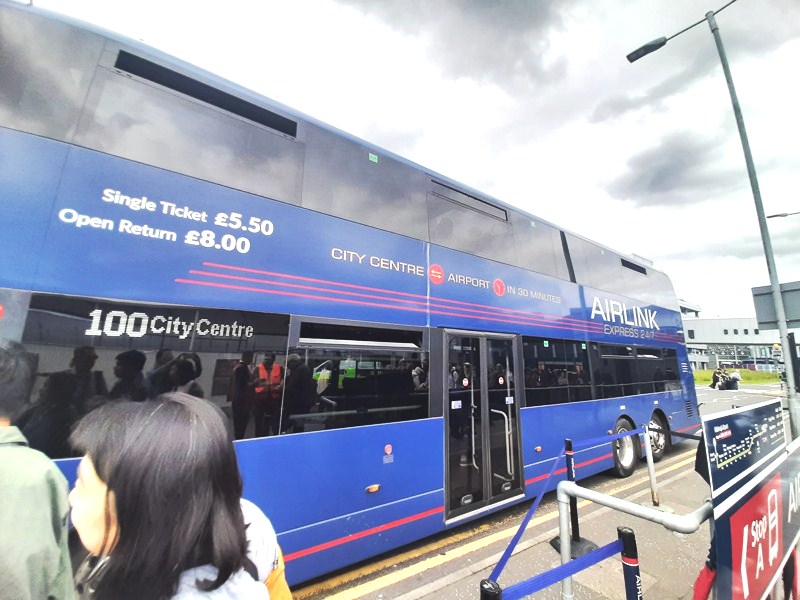After a long layover of 18 hours and 45 minutes at Istanbul Airport (IST) in Turkey, where we joined Touristanbul’s Bosphorus River cruise (from 6:30PM-11PM), we finally departed the airport at 7:15 AM, Monday, June 17, and arrived at Edinburgh International Airport (EDI) in Edinburgh, Scotland at 9:40AM, that same day, on board Turkish Airlines Flight Number TK1343. The flight took us 4 hours and 25 minutes.
Check out “Bosphorus Strait Cruise”
Edinburgh International Airport (IATA: EDI, ICAO: EGPH), the busiest airport in Scotland in 2019, is also the sixth-busiest airport in the United Kingdom by total passengers in 2019 (despite only having one terminal and two runways), handling over 14.7 million passengers. However, it is a relatively small airport compared to Heathrow International Airport in London. Owned and operated by Global Infrastructure Partners, (also a minority shareholder of Gatwick Airport), it has one runway and one passenger terminal and employs about 2,500 people.
Check out “Heathrow International Airport”
Here’s the historical timeline of the airport:
- In 1916, the small Turnhouse Aerodrome was opened
- In World War I, it was the northernmost British air defense base used by the Royal Flying Corps.
- From 1925, it was used to house the 603 (City of Edinburgh) Squadron which consisted of DH 9As, Westland Wapitis, Hawker Harts, and Hawker Hind light bombers. All the aircraft used a grass airstrip.
- In 1918, the Royal Air Force was formed and the airfield was named RAF Turnhouse and ownership was transferred to the Air Ministry.
- When the Second World War broke out, RAF Fighter Command took control over the airfield and a runway of 3,900 ft (1,189 m) was paved to handle the Supermarine Spitfire.
- During the Battle of Britain, 3, 65, and 141 Squadrons were present at the airbase.
- When the war ended, the airfield remained under military control.
- On May 19, 1947, it was officially opened for commercial traffic. The first commercial flight to use the airport was a British European Airways service (an 18-seater Douglas C47) from London (Northolt) to Shetland, with Edinburgh and Aberdeen being intermediate stopping points.
- In 1952, the runway was extended to 6,000 ft. to handle the Vampire FB5soperated by the resident 603 Squadron, and an aircraft arresting barrier net was installed to protect traffic on the adjacent A9 road. The net remained in place until the early 1970s and was used to stop one of the Ferranti Flying Unit Buccaneers which had overrun the runway.
- In 1956, a new passenger terminal was built to provide an improved commercial service.
- In March 1957, the 603 Squadron was disbanded
- In 1960, the Air Ministry transferred ownership to the Ministry of Aviation to offer improved commercial service to the airport. Flying was temporarily diverted to East Fortune, which had its runway extended to accommodate the airliners of the period.
- In 1961, the passenger terminal was extended.
- In 1962, international service from Edinburgh began with direct service to Dublin but, for many years, international flights were charter and private only.
- In 1970, a Meteor TT20, operated by the RN Fleet Requirement Unit, overran the runway and ended up in the net.
- On April 1, 1971, the British Airports Authority (BAA) took over ownership of the airport at a time when the original terminal building was running at about eight times its design capacity. Immediate improvements to the terminal were cosmetic, such as extra seating and TV monitors for flight information, and it took two years for plans to be proposed for a completely new terminal and runway redesign.
- In November 1971, public consultation on planning was started
- In February 1972, the consultation was ended.
- In June 1973, the initial stages of the redevelopment began. They included a diversion of the River Almond.
- In 1975, direct services to Amsterdam, in continental Europe, was started.
- In March 1975, work on the new terminal building, designed by Sir Robert Matthew, was started.
- In 1977, the new 2,556 m. (8,386 ft.) long 07/25 runway (which has since become 06/24), completely outside the original airfield boundary, was completed, and was able to take all modern airliners including the Concorde. Although the original main runway 13/31 (which is now 12/30) served the airport well, its alignment (NW-SE) had the disadvantage of suffering from severe crosswinds, and the other two minor runways were very short and could not be readily extended.
- On May 27, 1977, the new terminal building, alongside the new runway, was officially opened by Queen Elizabeth II to cater for the additional traffic. The old terminal and hangars were converted into a cargo centre.
- On May 29, 1977, the building was opened to the public. Since the original terminal upgrade, there have been major reconstructions, including extensions of the two passenger terminal aprons and a major expansion of car parking facilities.
- By the mid-1980s, direct routes included Paris, Düsseldorf, Brussels, Frankfurt and Copenhagen, but direct transatlantic flights were not yet possible as Glasgow-Prestwick was the only “designated gateway” in Scotland under the US-UK Bermuda II Agreement.
- In 1987, by the time BAA had been privatized, Edinburgh Airport handled over 1.8 million passengers each year; compared to the 681,000 passengers handled in 1971 when BAA first took control of the airport.
- In 1997, the RAF Turnhouse, operational near the passenger terminal of the airport for all of the post-war period, was finally closed.
- In 2005, a new 57-m. (187 ft.) tall air traffic control tower was completed for £10 million.
- In September 2006, an extension to the terminal, called the South East Pier, was opened. This extension initially added six gates on a new pier to the southeast of the original building.
- At the end of 2008, a further four gates were added to the South East Pier.
- On October 19, 2011, BAA Limited announced its intention to sell the airport, following a decision by the UK’s Competition Commissionrequiring BAA to sell either Glasgow Airport or Edinburgh Airport.
- On April 23, 2012, BAA announced that it had sold Edinburgh Airport to Global Infrastructure Partners(GIP) for a price of £807.2 million (equivalent to £1204 million in 2023).
- In 2013, a further extension to the passenger terminal was announced, taking the terminal building up to the Edinburgh Airport tram stop.
- In May 2014, the Edinburgh Trams, running between Edinburgh Airport and York Place, was opened, creating the first rail connection to Edinburgh Airport.
- In February 2016, consultancy firm Biggar Economics announced that Edinburgh Airport contributes almost £1 billion annually to the Scottish economy.
- On February 23, 2016, Ryanair announced a growth of 20% in passenger numbers, bringing the airline’s annual passenger capacity at Edinburgh Airport to 2.5 million. This was coupled with the news of six new services to Ryanair’s winter schedule from Edinburgh and more services on its popular European destinations.
- On March 29, 2018, as part of the expansion works, Runway 12/30 was officially withdrawn from use.
- In 2004, a multi-storey car park was opened.
- In 2014, whilst the number of passengers has increased, the number of flights decreased due to planes operating at a higher capacity.
- In 2015, passenger traffic at Edinburgh Airport reached a record level with over 11.1 million passengers and over 109,000 aircraft movements.
- On April 17, 2024, Vinci announced that it had reached an agreement with GIP to acquire a 50.01% shareholding of the airport for £1.27 billion, with GIP retaining 49.99%. The transaction is expected to close mid-2024.
The airport has flights to 157 destinations worldwide and 38 airlines (American Airlines, British Airways, Delta Airlines, Lufthansa, Turkish Airlines, United Airlines, etc.) operate in and out of the airport. It can be particularly busy during summer, the holidays and during popular events such as the Edinburgh Fringe Festival.
Direct flights are available between several U.S. cities and flights are also available to the Middle East. The airport has won a number of awards including Best European Airport.
The terminal building is currently being expanded with an investment of £40 million. A new £25 million expansion project, involving the construction of a new 6,000 sq. m. building, housing a security hall and retail areas, is also currently underway at the airport. In 2005, after a 15-month construction, its new 57 m. (187 ft.) high, £10 million control tower, with its façade of 9,216 hand-installed zinc tiles and crisscross, double helix pattern (which functions as a system of drainage channels), was inaugurated.
Upon claiming our luggage, we proceeded outside the terminal building to Stop A where we boarded an Airlink bus (Edinburgh’s dedicated express service between the airport and the city center), which arrives every 10 mins., to take us into the city. Fare was £5.50 for a one-way single adult ticket and the trip took us about 30 mins. Upon reaching the city, we walked for about 10 minutes, from Princes Street, to Frederick House Hotel (42 Frederick St., Edinburgh EH2 1EX, United Kingdom) where we had our luggage stored prior to check in.
Check out “Hotel and Inn Review: Frederick House Hotel”
Edinburgh Airport: Ingliston area, Edinburgh EH12 9DN, Scotland. Tel: 44 131 357 6337 and +44 131 322 5283. Website: www.edinburghairport.com. Coordinates: 55°57′00″N 003°22′21″W / 55.95000°N 3.37250°W.
How to Get There: Edinburgh Airport is located 5 NM (9.3 kms.; 5.8 mi.) west of the city center, just off the M8 and M9 motorways. It is widely served by buses of Airlink 100, Skylink 200 and 400, and Airport Express Services. Trams also operate from the airport to Edinburgh city center, departing every 7 mins., between 7 AM and 7 PM, and every 10 mins. early in the morning and later in the evening. The first tram of the day departs the airport at 6:26 AM and the last train departs at 10:48 PM.

